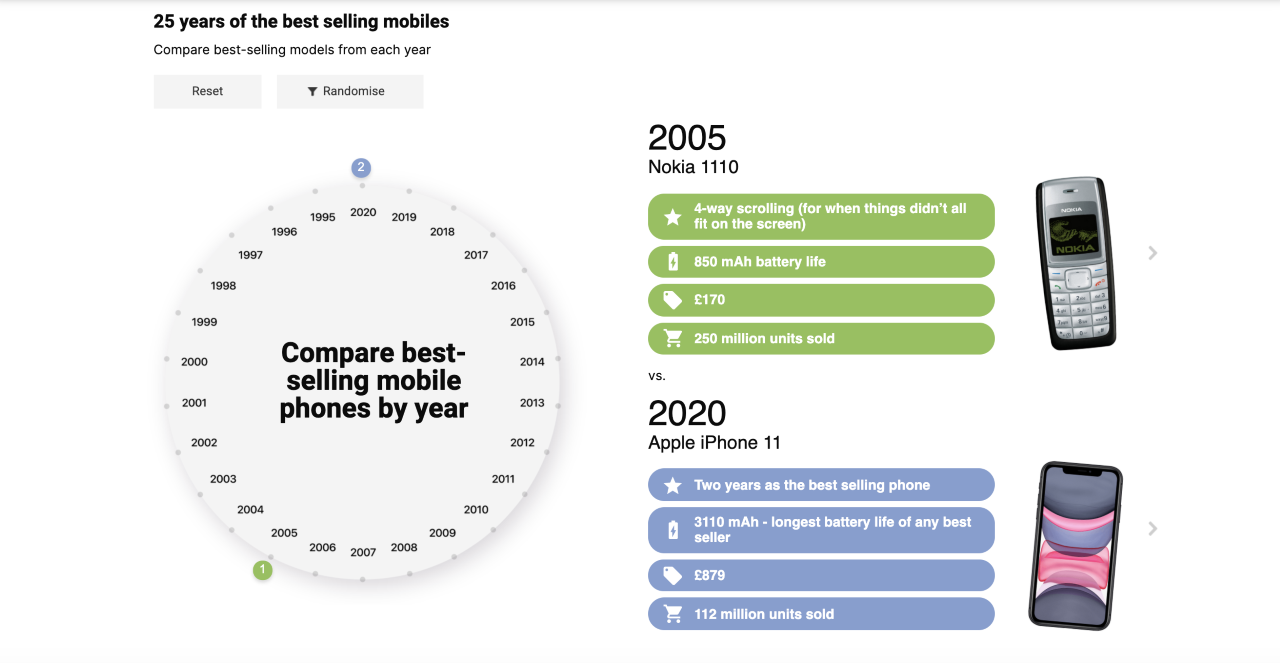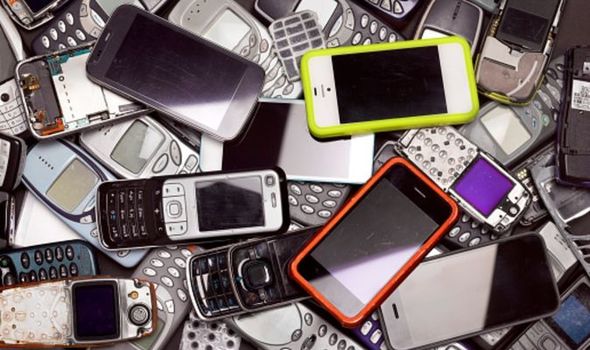A new interactive comparison tool launched by Uswitch has revealed the best-selling mobile handsets of the past twenty-five years, and revealed which phones have been the best-value over the past quarter of a century!
Nokia 1110 remains the best ever seller, with over 250 MILLION units sold

Image: Uswitch.com
2005’s best-seller, the Nokia 1110 may seem pretty basic in comparison to the smartphones of today, but it’s low cost revolutionised the market, allowing more people to own a mobile phone than ever. The handset sold over 250 million units worldwide, a feat that hasn’t been beaten to this day.
Best-selling phones by units sold
| Number. | Handset model | Year | Units sold |
| 1 | Nokia 1110 | 2003, 2005 | 250,000,000 |
| 2 | Apple iPhone 6 | 2014 | 224,400,000 |
| 3 | Nokia 105 | 2013 | 220,000,000 |
| 4 | Nokia 3210 | 1999 | 160,000,000 |
| 5 | Nokia 5230 | 2009 | 150,000,000 |
| 6 | Samsung E1100 | 2009 | 150,000,000 |
| 7 | Nokia 1200 | 2007 | 150,000,000 |
| 8 | Nokia 2600 | 2004 | 135,000,000 |
| 9 | Nokia 1600 (1650/1661) | 2006 | 130,000,000 |
| 10 | Motorola RAZR V3 | 2004 | 130,000,000 |
| 11 | Nokia 3310 | 2000 | 126,000,000 |
| 12 | Nokia 1280 | 2010 | 100,000,000 |
| 13 | Apple iPhone 8 | 2017 | 86,300,000 |
| 14 | Apple iPhone 7 | 2016 | 78,300,000 |
| 15 | Apple iPhone XR | 2018 | 77,400,000 |
| 16 | Apple iPhone 11 | 2019 | 75,000,000 |
| 17 | Apple iPhone 5 | 2012 | 70,000,000 |
| 18 | Samsung Galaxy S III | 2012 | 70,000,000 |
| 19 | Motorola StarTAC 75+ | 1996 | 60,000,000 |
| 20 | Apple iPhone 4S | 2011 | 60,000,000 |
| 21 | Samsung Galaxy S6 | 2015 | 45,000,000 |
| 22 | Nokia 6120 | 1998 | 21,000,000 |
| 23 | Nokia E71 | 2008 | 15,000,000 |
| 24 | Nokia 5800 XpressMusic | 2008 | 15,000,000 |
Table: The phones that were the best-sellers by year from 1995 to 2020.
Motorola StarTAC would still cost the most in today’s money
Whilst many of the latest iPhones have come just shy of the £1,000 mark, this actually pales into comparison compared to the cost of some of the earlier handsets. The Motorola StarTAC, which was the best-selling phone from 1995-1997 and the world’s first ‘flip-phone’ had a cost-price of £1,400 – which would be a whopping £2,251 in today’s money if adjusted for inflation.
The iPhone 11 is best for battery, but it’s all relative
As phones have increased in capability, so has the demand on their batteries. The modern models have the biggest battery capability, with the iPhone 11 coming in at 3110 mAh (Milliamps hour). Ultimately, the more mAh a device has, the better the battery. However, smartphone battery usage is incredibly demanding compared to devices of old. The Motorola RAZR V3 for example had 680 mAh, but far less capability than the latest iPhone – meaning it’s battery would last longer.
The Nokia 3310 released in 2000 was lauded for it’s long-lasting battery life at the time, capable of 55 hours on standby mode, but its capability would be tested if it had the capabilities of today’s smartphones.
The newly announced iPhone 12 actually has a smaller battery size at 2815 mAh than the iPhone 11, meaning that the more demanding phone is less likely to hold out against it’s predecessor.
Blackberry never tops the list, despite revolutionising market
Some infamous handsets didn’t actually make the best-seller list. Whilst Blackberry phones seemed a staple for many with it’s recognisable QWERTY keyboard design, it battled Apple for market dominance before stopping producing handsets altogether in 2016. The original iPhone released in 2007 only sold 6.1 million units as consumers stuck to designs that were more tried and tested – it took until 2011 for the iPhone 4S to become Apple’s first best-selling phone.
How does the iPhone 12 compare?
Whilst the battery life is comparably smaller than that of it’s predecessor the iPhone 11, at a cost of £799 for a 64GB model it would still sit in our top ten most expensive handsets of the past twenty-five years. Are we looking at the potential best-seller of 2021? Only time will tell.
Rehan Ali, mobiles expert at Uswitch.com comments:
“It really is incredible to look back at the phones of yesteryear and see how the technology has changed over the past quarter of a century.
“Handsets which would have been considered game changing at the time, are now looked upon as basic bricks of plastic, only good for use as paperweights or museum displays.
“However, within the last five years, we’ve seen a significant shift in smartphone durability. Many devices can now last for up to five or six years, without the need to upgrade, as changes between models are more nuanced.
“One factor which has always been relevant is battery life, because no matter what phone you have, if it can’t last you the best part of a day, it is as useful as some of the older phones in our study.
The full interactive asset, and more information on the best-sellers from 1995 to 2020 can be found here.










Recent Comments